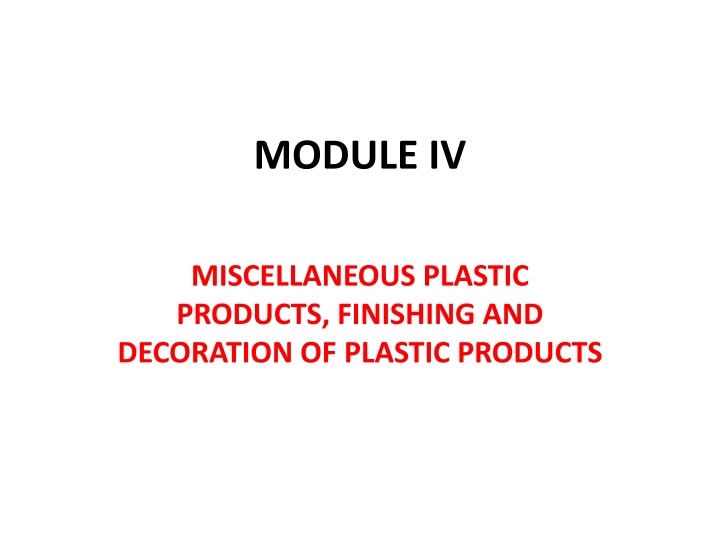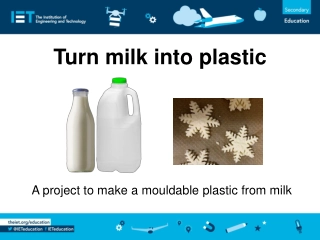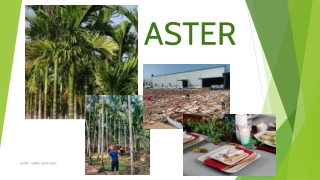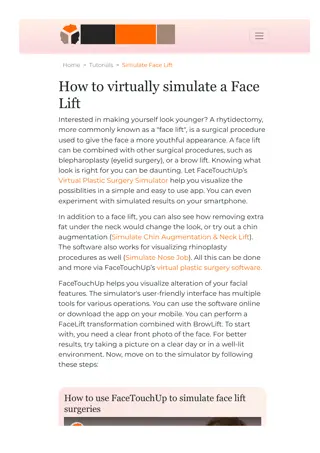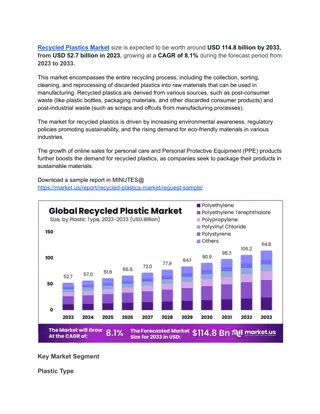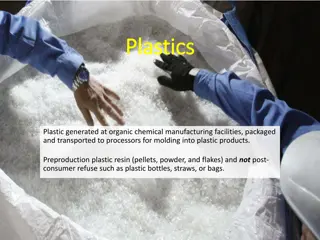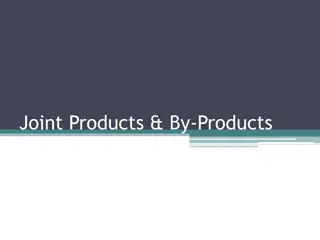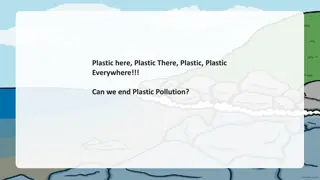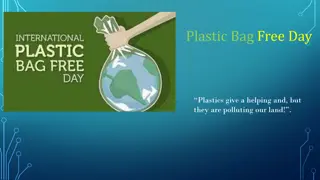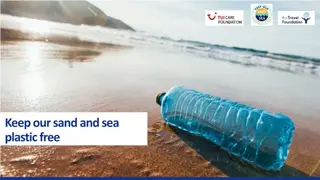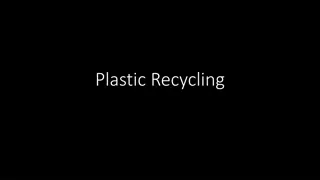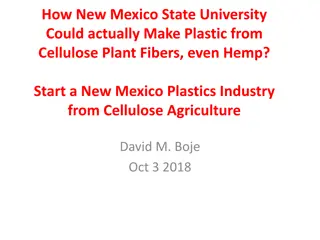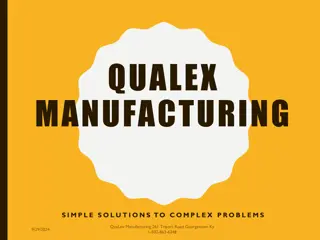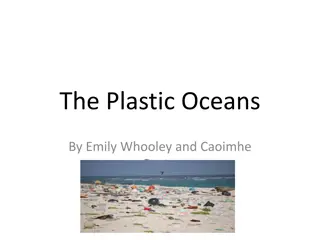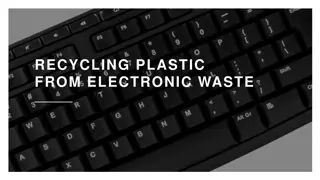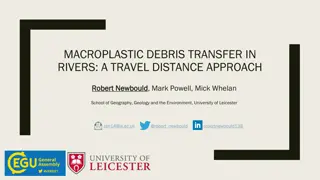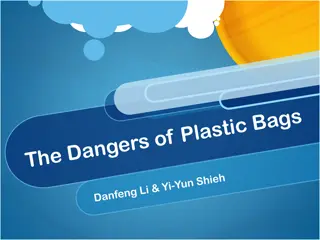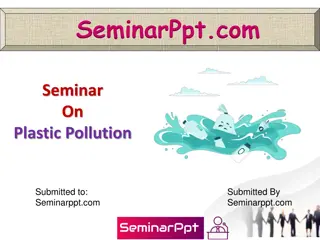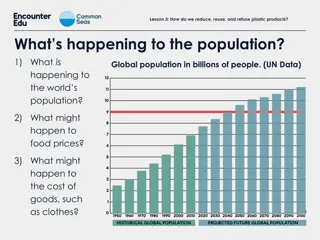Manufacturing and Finishing Techniques of Plastic Products
Learn about various manufacturing processes of plastic products including casting, compression molding, transfer molding, and more. Explore the production of PMMA sheets through cell casting and other methods. Discover the intricacies of finishing and decorating plastic products with operations like tumbling, grinding, painting, coating, and more.
Download Presentation

Please find below an Image/Link to download the presentation.
The content on the website is provided AS IS for your information and personal use only. It may not be sold, licensed, or shared on other websites without obtaining consent from the author.If you encounter any issues during the download, it is possible that the publisher has removed the file from their server.
You are allowed to download the files provided on this website for personal or commercial use, subject to the condition that they are used lawfully. All files are the property of their respective owners.
The content on the website is provided AS IS for your information and personal use only. It may not be sold, licensed, or shared on other websites without obtaining consent from the author.
E N D
Presentation Transcript
MODULE IV MISCELLANEOUS PLASTIC PRODUCTS, FINISHING AND DECORATION OF PLASTIC PRODUCTS
4.4.0 To understand the cast plastic products, expanded products , powder coated products, compression and Transfer moulded products 4.4.1. Identify plastic products produced by Casting ,Compression moulding ,Transfer moulding, foaming and Coating . 4.4.2. Explain the manufacturing of PMMA sheets 4.4.3. Describe Bakelite and Meloware moulding 4.4.4. Explain the manufacture of inserted plastic products 4.4.5. Explain the manufacture of rigid and flexible PU foam . 4.4.6. Describe the manufacture of powder coated plastic products
4.5.0 To understand the different methods of finishing and decoration of plastic products 4.5.1. State the purpose of finishing and machining operations of plastic products 4.5.2 Explain the finishing operations such as tumbling , grinding and sanding ,trimming ,joining and assembling and buffing 4.5.3. List the various finishing operations of plastic products 4.5.4. Describe the processes Printing , Electro plating ,Painting ,Coating , Lazer marking, Vaccum metalizing and labeling of plastic products
PMMA sheet The process consists of mixing monomer with catalyst (organic peroxide), and colouring agents , poured into a mould where the reaction takes place. Highest quality PMMA sheets are produced by Cell casting. Other process includes Extrusion Continuous casting
PMMA sheets The mould for producing sheets is assembled from two plates of polished glass separated by a flexible "window-frame" spacer. The spacer sits along the outer perimeter of the surface of the glass plates and forms a sealed cavity between the plates. Mould cavity is filled with a pre-measured liquid syrup of methyl methacrylate monomer and catalyst. The mold is then sealed and heat may be applied to help the catalyst start the reaction. As the reaction proceeds, it may generate significant heat by itself. Temperature carefully monitored to control reaction to ensure a good polymerization.
PMMA sheets When the plastic is cured, the moulds are cooled and opened. The glass or metal plates are cleaned and reassembled for the next batch. The plastic sheets are either used as is or are annealed by heating them to 284-302 F (140-150 C) for several hours to reduce any residual stresses in the material that might cause warping or other dimensional instabilities. Any excess material, or flash, is trimmed off the edges Masking paper or plastic film is applied to the surface of the finished sheets for protection during handling and shipping
Batch cell is simple and is easily adapted for making acrylic sheets in thicknesses from 0.06 to 6.0 inches (0.16-15 cm) and widths from 3 feet (0.9 m) up to several hundred feet.
PU Foam PU are formed by the reaction between polyols and diisocyanate , resulting in urethane linkages. Two types of PU foam Flexible foam (open cell structure) Rigid Foam ( Closed cell structure)
Flexible Foam There are two main reactions in the production of flexible PU foam Blow reaction Gelation reaction Blow reaction Reaction of water with isocyanate is a two step process termed as blow reaction since a gas is evolved which plays a large role in blowing the liquid into foam. Auxiliary blowing agents can also be utilised
Initial step of blow reaction generates unstable carbamic acid Carbamic acid decomposes spontaneously yielding heat , CO2 , amine. CO2 causes expansion of foam; heat generated will also plays an important role in expanding the gas
In the second step , the newly formed amine group reacts with another isocyanate group to give a disubstituted urea and additional heat is generated. The total heat generated from the blow reaction is approximately 47 kcal per mole of water reacted, along with the carbon dioxide released in the first step and serves as the principal source for blowing the foam mixture, though some auxiliary blowing agents (CFC and HCFC) are also usually utilized.
Gelation reaction The gelation reaction, also sometimes called the polymerization reaction, involves the reaction of an isocyanate group with an alcohol group to give a urethane linkage. The heat of this reaction is reported to be approximately 24 kcal per mole of urethane Since polyurethane foams usually utilize polyfunctional reactants (typically difunctional isocyanates and trifunctional polyols), this reaction leads to the formation of a cross linked polymer. Applications : Vibration damping, Sports mat, Toys, Sound insulation etc.
Rigid PU foam They are produced through chemical reaction between two base components in liquid form and a low boiling blowing agent such as pentane or CO2. Base materials reacts directly on mixing and build a polymer matrix Base components are mixed in agitator before being poured into a box mould. The reaction mixture expands and form a rigid foam block. Applications : thermal insulation material, sandwich panel, insulation, lining in refrigerator
Inserted Plastic products Transfer moulding technique is used for making inserted plastic products. Transfer moulding process combines the principle of compression and transfer of the polymer charge.
The required amount of resin is weighted and inserted into the transfer pot before the moulding process. The resin is preheated in the transfer pot. The transfer pot is heated by the heating elements above the melting point of the resin. This allows a faster flow of material through the sprue into the mould cavity. A plunger is used to push the material from the transfer pot through sprue into the mould cavity. A piston and cylinder arrangement is built in the transfer pot so that the resin is squirted into the mould cavity through a sprue. The mould is held closed until the resin gets cured. The mould cavity is opened and the moulded part can be removed with the help of ejector pin.
Bakelite and Meloware Moulding Compression moulding technique is used for Bakelite and Meloware moulding Compression molding process is one of the low cost molding methods as compared to injection molding and transfer molding. It is a high pressure forming process in which the molten plastic material is squeezed directly into a mould cavity, by the application of heat and pressure to conform to the shape of the mold.
In compression molding of thermosets the mold remains hot throughout the entire cycle; as soon as a molded part is ejected, a new charge of molding powder can be introduced.
Powder Coating Powder coating is a finishing process in which dry, free-flowing, thermoplastic or thermoset powder material is applied to a surface, melted, and hardened into an even coating. This finishing process is suitable for various materials, including metals, plastics, glass, and medium density fiberboard (MDF). They can provide both functional and decorative surface coatings in a wide range of colors, finishes, and textures that are not readily achievable by conventional liquid coating methods.
There are two main methods of powder coating electrostatic spray deposition (ESD) fluidized bed application Pre-treatment for Powder The first step in the powder coating process is to prepare or pretreat the parts. The product to be coated is exposed to cleaning and pre-treatment operations to ensure that surfaces to be coated are clean and free of grease, dust, oils, rust and other contaminants.
Electrostatic Spray Deposition Corona charging is the most common application method used in powder. The process disperses finely ground powder into an airstream, producing a cloud as it exits the gun. The particles pass through a highly charged and ionized corona field at the gun tip, applying a strong negative charge to each particle. These particles have a strong attraction to the grounded part and deposit there. After the part has been electrostatically coated, it is heated in an oven to fuse the coating
Advantages 1) Difficult shapes can be coated 2) Film thickness between 30-250 3) Simple and low cost for automation 4) Colour can be changed relatively simply 5) No pre-heating of components required Disadvantage 1) Cost of equipment is higher than a fluidised bed
Fluidised Bed Coating It uses dry powder in a fluidised state mixed with air. Fluidised tank has a porous bottom through which air or inert gas passes This air or gas at low pressure mixes with powder, holding it in suspension so that it acts like a fluid The part to be coated is pre-heated above the fusion temperature of powder, dipped for a few seconds in the fluidised bed. Powder melts and bonds to heated surface in a uniform thickness
Advantages: Uniform coating Product reliability Thick coatings Complex parts 100% coverage Good edge coverage Good process control Disadvantages: Pre-heat and post-heat ovens required Larger heavy parts must be manipulated into bed Thinner substrates do not hold heat, difficult to coat Complex shapes trap excess powder Minimum of 8 mils to be applied
Finishing Operations Machining and finishing are sometimes used to provide molded parts with a desired look or added functionality needed for assembly. These operations are more commonly used for fabricating prototypes and for trimming or modifying parts produced by thermoforming or extrusion. Grinding and sanding (abrasive grinding) Tumbling Trimming Joining Assembling Buffing
Grinding and sanding (abrasive grinding) Grinding is a mechanical surface treatment method for removing the uppermost layers of the substrate and exposing the actual base substrate. Grinding plastics can pose a problem in TP due to the generation of heat . As the plastic softens from the heat, the grinding wheel will clog and load up generating more friction and then melting at the part surface, resulting in very poor surface finish. Freezing the plastic, using coolant prior to grinding can alleviate the overheating by making the material harder and more brittle as well as cool. Parts may be kept in a chest freezer near the grinding machine and then fixture and ground Abrasive grinding is a useful method of finishing thermosets especially those containing fillers and reinforcement Trimming Removal of flash using tools such as scissors
Buffing Removal of small surface defect and to obtain lustrous surface Buffing sequence often include ashing, polishing and wiping The ashing wheel is kept dressed with a slurry of pumice and water during the buffing operation. The part is held lightly against the wheel and kept in constant motion to prevent burning or uneven ashing. Wheel must be rotated slowly, when ashing is completed part is rinsed and dried A polishing compound is applied to half the surface of the wheel (operated dry ) The other half remains untreated. The part is first held against the treated half of the wheel for polishing and then moved to the untreated side to wipe off the polishing compound.
Tumbling Process of tumbling parts in a rotating barrel In addition to the parts to be tumbled, barrel is also charged with abrasive or a polishing compound for finishing Used to remove flash, to smooth rough corners, to grind or to polish May be done wet ( to remove material) or dry (supply polish)
Joining methods Mechanical fastening make use of additional parts (fasteners) such are polymeric of metallic screws, bolts, washers, rivets or it relies on integrated design elements such as snap-fit or press-fit joints. Mechanical fastening can be used to join both similar and dissimilar materials. Advantages - no surface treatment is required and disassembly of the components for inspection and repair is straight forward. Limitations - increased weight, the presence of large stress concentrations around the fastener holes, and subsequent in-service corrosion problems. Applications - in the aerospace, automotive, and construction industries.
Adhesive bonding, an adhesive is placed between the parts to be bonded (adherends) where it serves as the material that joins the parts and transmits the load through the joint. In solvent bonding, the application of a solvent at the bond line induces sufficient mobility for the polymer chains to interdiffuse. Since solvent must strongly plasticize the polymer surface, this joining technique is primarily applied to glassy amorphous thermoplastics, such as polycarbonate (PC), acrylic (AK), and polystyrene (PS) resins. Advantages : low cost and adaptability to high-speed production, uniform distribution of stresses over the assembled areas and a high strength to-weight ratio. Solvent bonding is applicable only for joining of amorphous thermoplastics, whereas adhesive bonding can be used with almost all plastics.
Welding / fusion bonding A welding rod and a welding gun is required for the process Application of heated gas from a gun usually air or nitrogen , applied to edges of sheet. Heating results in melting the polymeric material at contacting surfaces enabling through intermolecular diffusion and polymeric chains entanglement processes to form a joint. Assembling A variety of fasteners are employed in assembling plastic products which includes nuts and bolts, inserts, washers, rivets etc.
Decoration of plastics Printing Electro plating Painting Coating Laser marking Vacuum metalizing Labeling
Painting Surface preparation of T.P for painting usually requires only a solvent wipe. Surface to be painted must be free from dust, mould release, wax, plasticizer etc. Involves application of a liquid coating onto the plastic surface. The coating is dried or otherwise solidified after it has been applied to the surface in the required manner and at the required thickness. Applied by automatic spraying or by manually and dipping.
Electroplating Most of plastics can be electroplated Plastic surface is first degreased, dried and then made electrically conductive by depositing Cu by chemical methods The electroplated metal usually , Chromium is then deposited. Sometimes electroplated part is given a final coat of lacquer Laser marking Ink- free process which produces a permanent rub-fast, solvent resistant, scratch proof mark with no waste. It is a thermal process that employs a high intensity beam of focused laser light to create a contrasting mark on the material surface As the target material absorbs the laser light, surface temperature increases to induce either a colour change in the material and or displace material by vaporization to engrave the surface
Vacuum metalizing/ vacuum deposition It is a form of physical vapour deposition A process of coating a metal such as Al ( most common due to low cost) or Cu to a non-metallic substrate through evaporation Evaporation of metal takes place by feeding Al wire onto a heated source (1500 C) Process takes place in a closed chamber under high vacuum, which allows the liquid metal to go from a condensed phase to vapour phase. Al vapour adheres to the surface of substrate, producing a metal coating on a film or fabric Vacuum deposited Al coating is uniform across the entire web of the substrate.
Coating A layer of a substance applied onto a surface for protection or decoration, a covering layer Can be done using painting, powder coating etc. Labelling Serves as integral part of final product, which is delivered as pre- decorated item In-mould labelling is most common, in which pre-printed film label is placed in the mould before the part is created Label Fuses to the hot plastic material as it is moulded, combining the production n and labelling the need for post mould labelling.
